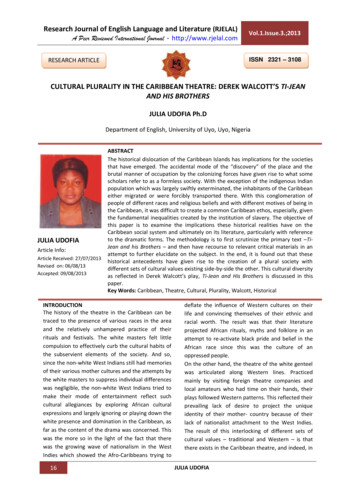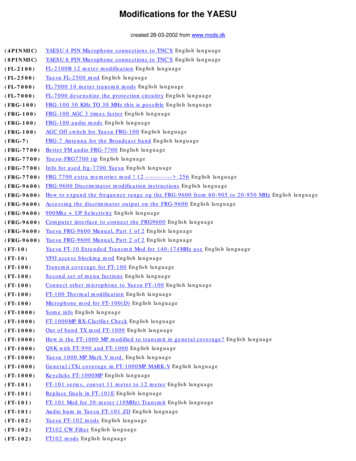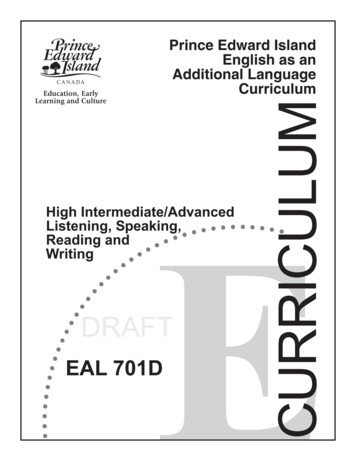
Transcription
Research Journal of English Language and Literature (RJELAL)A Peer Reviewed International Journal - http://www.rjelal.comVol.1.Issue.3.;2013ISSN 2321 – 3108RESEARCH ARTICLECULTURAL PLURALITY IN THE CARIBBEAN THEATRE: DEREK WALCOTT’S TI-JEANAND HIS BROTHERSJULIA UDOFIA Ph.DDepartment of English, University of Uyo, Uyo, NigeriaJULIA UDOFIAArticle Info:Article Received: 27/07/2013Revised on: 06/08/13Accepted: 09/08/2013ABSTRACTThe historical dislocation of the Caribbean Islands has implications for the societiesthat have emerged. The accidental mode of the “discovery” of the place and thebrutal manner of occupation by the colonizing forces have given rise to what somescholars refer to as a formless society. With the exception of the indigenous Indianpopulation which was largely swiftly exterminated, the inhabitants of the Caribbeaneither migrated or were forcibly transported there. With this conglomeration ofpeople of different races and religious beliefs and with different motives of being inthe Caribbean, it was difficult to create a common Caribbean ethos, especially, giventhe fundamental inequalities created by the institution of slavery. The objective ofthis paper is to examine the implications these historical realities have on theCaribbean social system and ultimately on its literature, particularly with referenceto the dramatic forms. The methodology is to first scrutinize the primary text –TiJean and his Brothers – and then have recourse to relevant critical materials in anattempt to further elucidate on the subject. In the end, it is found out that thesehistorical antecedents have given rise to the creation of a plural society withdifferent sets of cultural values existing side-by-side the other. This cultural diversityas reflected in Derek Walcott’s play, Ti-Jean and His Brothers is discussed in thispaper.Key Words: Caribbean, Theatre, Cultural, Plurality, Walcott, HistoricalINTRODUCTIONThe history of the theatre in the Caribbean can betraced to the presence of various races in the areaand the relatively unhampered practice of theirrituals and festivals. The white masters felt littlecompulsion to effectively curb the cultural habits ofthe subservient elements of the society. And so,since the non-white West Indians still had memoriesof their various mother cultures and the attempts bythe white masters to suppress individual differenceswas negligible, the non-white West Indians tried tomake their mode of entertainment reflect suchcultural allegiances by exploring African culturalexpressions and largely ignoring or playing down thewhite presence and domination in the Caribbean, asfar as the content of the drama was concerned. Thiswas the more so in the light of the fact that therewas the growing wave of nationalism in the WestIndies which showed the Afro-Caribbeans trying to16deflate the influence of Western cultures on theirlife and convincing themselves of their ethnic andracial worth. The result was that their literatureprojected African rituals, myths and folklore in anattempt to re-activate black pride and belief in theAfrican race since this was the culture of anoppressed people.On the other hand, the theatre of the white genteelwas articulated along Western lines. Practicedmainly by visiting foreign theatre companies andlocal amateurs who had time on their hands, theirplays followed Western patterns. This reflected theirprevailing lack of desire to project the uniqueidentity of their mother- country because of theirlack of nationalist attachment to the West Indies.The result of this interlocking of different sets ofcultural values – traditional and Western – is thatthere exists in the Caribbean theatre, and indeed, inJULIA UDOFIA
Research Journal of English Language and Literature (RJELAL)A Peer Reviewed International Journal - http://www.rjelal.comCaribbean literature in general, several culturalelements existing side-by-side the other.This cultural plurality as reflected in Derek Walcott’sTi-Jean and His Brothers (1970) is what is examinedin this paper. Born in Castries, St. Lucia, Walcott isracially mixed and he eagerly acknowledges his“mongrel” identity. This enables him to embraceboth Western and African influences. It is Walcott’sbelief that for true nationalism to exist and for theauthentic Caribbean personality to emerge, onecannot adopt one culture to the neglect of theother. This is why he consistently blends elements ofboth traditional West Indian and European culturesin his works. In coping with a changingcontemporary world, Walcott, like Selvon, believes ajudicious blend of both traditional and Westernways of life is what is needed.METHODOLOGYBeing a literary research, the work is mainly librarybased. First, Walcott’s play, Ti-Jean and his Brotherswhich is the primary text in this study has beenrigorously examined. Then, in a bid to strengtheningthe focus of the discussions, recourse has been hadto such relevant reference materials as journalarticles, reviews, critiques, books and reviews.Cultural Plurality in Ti-Jean and his BrothersBriefly summarized, the subject of Ti-Jean and HisBrothers (1970) centres around the traditionaltrickster figure who uses his innate cunning tooutwit the Devil. The play is based on the myth ofthe duel between three boys and the Devil. Withinthe world of the myth, Ti-Jean is characterized as alover, King and man in the moon. In the play,Walcott explores Ti-Jean’s strong survival instinctsand places particular emphasis on his potential as apossible West Indian leader.The Prologue of the play provides backgroundinformation about the characters and introduces themain source of conflict in the play. We are told thatthe play is about three boys who lived with theirmother in abject poverty in a hut on the fringes of amagical forest. We are also told about the boys’individual attempts to take up the Devil’s challenge.The Devil challenges the boys to make him feelanger, compassion or any kind of human emotionfor a reward, while their failure to achieve this endwill lead to the boys’ death.17Vol.1.Issue.3.;2013The Devil is described in awesome terms. He hasdead eyes, his skin is as white as a leper’s. He is alsothe owner of half of the world and the seat ofintrigue, evil and destruction. In the play, he appearsin the guise of the Papa Bois, the owner of theforest, white planter and colonialist. He has wreckedhavoc on the entire world. He lures blacks into hisplantation, exploits, outwits and finally eliminatesthem. By doing this, the Devil keeps the blacksperpetually in bondage. The Devil also tries toperpetuate the anonymity of the blacks as seenwhen he calls Gros-Jean everything except his realname. The implication here is that by imposing aname on somebody or something, one distorts thatperson’s or thing’s identity to suit one’s ownpurpose. This is all part of colonial brain-washingwhich Walcott identifies and protests against in theplay.The Prologue also encapsulates the basic qualities ofthe three boys which inform their struggle againstthe Devil. Gros-Jean, the eldest son is described asbeing very stupid despite his immense strength. Heis full of his self-importance and has boundlessconfidence in himself. To him, physical strength isthe key to success. Gros-Jean refuses to accept hismother’s advice, yet foolishly, later accepts theadvice of the old man of the forest whom he doesnot know. He ignores his mother’s injunction that heshould identify with the other inhabitants of theforest, i.e., the bird, the frogs and the insects, andrather, acts very disrespectfully and aggressivelytowards them. As a result, when he later requirestheir help, they desert him. Gros-Jean’s belief in thestrength of his arm is no match for the whiteplanter’s cunning and the latter succeeds in irritatingGros-Jean to the point of anger and frustration andthen devours him.Mi-Jean is described as being only half as stupid asGros-Jean. He is a fisherman with intellectualpotentials and his ambition to rise from being a poorfisherman to becoming a ship captain and later, alawyer, provides an index to Mi-Jean’s intellectualability and prefigures his slim chances of outwittingthe Devil. Mi-Jean feels that in his encounter withthe Devil, he is protected by his decision not to beaggravated into speech. His guiding principle is:Debate is just a hookOpen your mouth, the bait in!JULIA UDOFIA
Research Journal of English Language and Literature (RJELAL)A Peer Reviewed International Journal - http://www.rjelal.comAnd is you they going to juck (1970, 122).Yet, it is Mi-Jean’s love for debate on philosophicaland legal matters that is his undoing. He manifestssigns of mental slavery and derives pleasure fromidentifying with the white culture. Mi-Jean is thearchetypal mimic man who lacks respect for hisroots as is evident in his antagonism of the creaturesof the forest. His slavish mentality is a barrier topractical thought. So, the Devil easily outwits anddevours him.Through Mi-Jean’s defeat, Walcott warns the WestIndians of their impracticality of attempting todefeat the colonial master by imbibing themetropolitan culture and attempting to beat thewhites at their own game. This is an illustration ofwhat Walcott says in his essay, “What the TwilightSays”: “Once the New World black had tried toprove that he was as good as his master, when heshould have proved not his equality but hisdifference” (1970, 9).This is exactly what Ti-Jean does. Ti-Jean is vastlydifferent from his brothers. He is described as theman in the moon and by extension, the source ofinspiration to West Indians. The strategy he adoptsin his confrontation with the Devil is greatlydifferent from that of his brothers. Ti-Jean seeks andreceives his mother’s advice and blessing. On thestrength of this, he is friendly with the forestcreatures and in return, they help him in his duelwith the Devil. Ti-Jean refuses to obey the Devil andrather goes on the offensive and creates his ownrules which undermine the Devil’s authority and inthe end, provokes the devil to the point of showinganger. Ti-Jean’s guiding principle in thisconfrontation is to trust his instincts and exhibit rankdisobedience towards any repressive and evilauthority because as he says:Who with the Devil tries to play fair,Weaves the net of his own despair(1970,17).One of the questions raised in this play is: “what arethe possibilities of the emergence of a Caribbeanpersonality with the freeman’s sensibility?” Inaddition to this is the issue of the circumstancesunder which the Bolom can free itself from the Deviland achieve life.The Bolom is an unborn foetus which is the twilightzone of life. The outcome of the brothers’ struggle18Vol.1.Issue.3.;2013to outsmart the Devil will decide the Bolom’s fate oflife or death. So, this confrontation between theJean Brothers and the Devil is of utmost importanceto the Bolom. The Bolom is described in the play as:The ShriekOf a child which was strangled,Who never saw the earth lightThrough the hinge of the womb (1970, 97).The Bolom is a symbolic reference to those historicalmistakes which perverted the quality of life in theNew World and debased the meeting between theOld World and the New. The discovery of the NewWorld heralded an opportunity for the Old Worldinhabitants to start afresh. The New World held outa lot of progress of regeneration and symbolizedsomething pure and vital. However, this dream wasperverted by reality. The New World soon becamean extension of the Old World and becamecharacterized by greed and exploitation which led toslavery and later, the emergence of the plantationsociety.The West Indies can, as a whole be regarded as anaborted foetus. In Walcott’s opinion, thecircumstances which can give life to the Bolom i.e,the new and free Caribbean man are explored in theencounter between the three boys and the Devil. Bymaking Gros-Jean and Mi-Jean fail, Walcott rejectswhat they represent and their tactics of coping withthe ravages of history. Rather, Walcott projects TiJean’s native wit and cunning as well as hiscompassionate heart and respect for advice andlower creatures as the qualities necessary toovercome colonial domination and erase the WestIndian colonial mentality.The play can also be seen as one of greatrevolutionary potential. Walcott implies in the workthat the true revolutionary must seek co-operationfrom all elements of the society. Egoistic behaviourand emphasis on Western learning are shown to beof no use in this situation. In addition, the playasserts the themes of rebellion and liberation fromwhite tyranny. It attempts to liberate West Indiansfrom self-hate and myopia created by the colourbased ethic of slavery, as well as make them awareof the different ways in which they can look atthemselves and their environment.Nationalism involves the re-evaluation of the selfand of old values. It also embraces certain newJULIA UDOFIA
Research Journal of English Language and Literature (RJELAL)A Peer Reviewed International Journal - http://www.rjelal.comyardsticks for oneself and abandoning colonialmodels. For Walcott, the substitute for colonialmodels should not solely be derived from Africa orEurope but should involve an amalgamation of bothtraditional West Indian elements and Europeanvalues as the ideal form of nationalism since theWest Indians cannot adopt one culture to theneglect of the other. Walcott in fact, insists that itwould be abhorrent to him to say: “I wish we wereEnglish again” or “I wish we were African again” thatthe reality is that one has to build in the West Indies(1979, 285). To him, it is the duty of the West Indianto possess his land, tame and cultivate it and finallyproduce something original, for the West Indian“behind all his roles and faces possesses thepossibility of a rich, complex and integrated selfwhich is his by virtue of his experience” (1979, 285).In the play, the three different stages by which theAfro-Caribbean tried to come to terms with his exileand also fight his white oppressor are shown. Hisfirst response to oppression was violent as seen inthe slave revolts. Next, the ex-slave attempted toovercome the white master by acquiring thetrappings of Western culture, mainly througheducation. This response was also counterproductive since it focused on the imitation ofWestern models and revealed a fundamental lack ofconfidence on the black man’s part. The thirdresponse was a combination of aggression andhumility. It also heralded the triumph of the “small”man, i.e., the folk who were the most denigratedand under-rated members of the society. This formspart of Walcott’s revolutionary vision. For Walcotttherefore, the theatre is the preserve of the “small”people as he sees theatre in the everyday life of thepeople: in poverty, sex, obscenity and deprivation.His theatre is thus, that of victims and losers andone in which folklore provided the core of the dramaas evident in the play.Literature is generally accepted as the recreationand interpretation of life. It results from consciousacts of men in society and is the product of tensions,conflicts, anxieties and contradictions which makeup the community. The West Indian literary artistseeks to clarify history and eliminate moral issues ina milieu where the history of the people has beencharacterized by slavery, colonialism, uprootmentand dispossession. However, Walcott believes that19Vol.1.Issue.3.;2013servitude to the muse of history can only result in aliterature that is sociological, self-pitying and full ofrevenge. He has this to say about the literature:Yet most of our literature loitered inthe pathos of sociology, self-pitying,and patronized. Our writers whined inthe voices of twilight. Look at thispeople! They may be degraded, butthey are as good as you are. Look atwhat you have done to them”. Andtheir poems remained laments, theirnovels propaganda tracts, as if onegeneral apology on behalf of the pastwould supplant imagination, wouldspare them the necessity of great art.Pastoralists of the African revivalshould know that what is needed is notnew names for old things, or old namesfor old things, but the faith of using theold names anew, so that mongrel as Iam, something prickles in me when Isee the word Ashanti as with the wordWarwickshire, both baptizing thisneither proud nor ashamed bastard.This hybrid, this West Indian (1970, 910)Walcott thus, regards history as fiction which issubject to the vagaries of memory and thus, open tomisinterpretations or re-interpretations.The play, on the whole, reflects Walcott’s intentionwhich is to show the cultural plurality in theCaribbean theatre. In the play, both traditional WestIndian and European elements are fused together.For instance, while the chorus of forest creatures isreminiscent of the African animal fable that wastransferred to the Caribbean through slavery, thevery concept of the chorus derives from classicalGreek drama. And so, the play tackles the issue ofthe West Indians’ ” loyalty” for at least two cultures.It is Walcott’s belief that for true nationalism to existand for the authentic Caribbean personality emerge,one cannot adopt one culture to the neglect of theother. Exhibiting this double consciousness, Walcottconsistently blends elements of the two cultures inthe play and even attempts to re-evaluate certainaspects of colonial history. Even the myth on whichthe play is based – the myth of the duel betweenthree boys and the Devil – is derived from thetraditional trickster figure who uses his innatecunning to outwit the Devil.JULIA UDOFIA
Research Journal of English Language and Literature (RJELAL)A Peer Reviewed International Journal - http://www.rjelal.comA popular motif in Caribbean literature is that of the“castaway”, i.e., a man ship-wrecked on a barrenpiece of land and bereft of his original culturalidentity. With no past and a bleak presence andfuture, the “castaway” has to figure out how toreconcile the diverse cultures offered by the diverse“pasts” of the Caribbean. At the root of his dilemmais the problem of cultural identification with aparticular set of norms and folkways which couldprovide the framework for everyday life. This isparticularly important to Afro-West Indians becausethrough slavery and subsequent colonialism, theAfro-West Indians have been taught to relinquish, orat least, disparage their original African culture orlocally evolved black Creole culture, and throughtheir response to the deeply inculcated feeling ofworthlessness, they tend to identify themselves byan imitation of Western culture as can be seen inMi-Jean. And so, Walcott tries to help West Indiansre-assess their “castaway’ status and overcome thepain of alienation and dispossession by “pushing”them into an acceptance of their original loss andmoving beyond this void. To Walcott, the WestIndian must dispassionately explore and make peacewith his history and milieu and this cannot be doneby adopting one culture to the neglect of the other.Rather, the disparate facets of the West Indianexperience must be coalesced into the evolution ofthe new man and society.Walcott, thus, considers the problem of being heirto several cultures occasioned by the diverse racialgroups found in the West Indies. This is a commonpsychological dilemma of New World blacks.However, the author focuses his attempts on how toevolve the prototype of the ideal Caribbeanpersonality from the various influences in theCaribbean social system. To him, the West Indiansmust possess a federated consciousness which willenable them to accept their complex history anddifferent experiences. This complexity of the WestIndian experience is reflected in his works where hedraws his ideas and myths from both West Indianand European literary and cultural expressions asevident in Ti-Jean and His Brothers. It would seemWalcott agrees with Selvon on this point since thelatter urges West Indians in A Brighter Sun and Turnagain Tiger to possess a federated consciousnesswhich will enable them to rise above trivial ethnic20Vol.1.Issue.3.;2013considerations. Edgar Mittleholzer puts it moresuccinctly when he observes thus :If the West Indies was to evolve aculture individually West Indian, itcould only come out of the wholehotch-potch of racial and naturalelements of which the West Indies iscomposed; it could not spring onlyfrom the negro. (1950, 215).And so, it is Walcott’s belief that the West Indiansmust come to terms with their complex historywhich will enable them to embrace their dual racialand cultural heritage as demonstrated in this play.CONCLUSIONFrom the above discussion, it can be concluded thatWalcott is a poet of reconciliation in as much as heaccepts the dual racial and cultural heritage of theWest Indies and also discourages the West Indiansfrom confronting the past with rancour as evident inthe play. Aware of the historical dislocation of theIslands and of the cultural, linguistic andpsychological responses which West Indians had tomake in the Disapora, Walcott tries to resolve thecontradictions inherent in this experience byexploring how these disparate facets of life cancoalesce into the evolution of the new man andsociety. He tries to help West Indians puzzle outtheir cultural and racial allegiances as well as find apanacea for their sense of displacement.The concept of the “castaway” refers not only to thephysical and psychological dispossession of the WestIndians, but also to the spiritual dispossession oftheir homeland. However, to Walcott, the“castaway” is not helpless and despairing. He isencouraged to turn his isolation into somethingpositive. Just as Crusoe learns to fashion somethingout of nothing and learns new methods of survival,the West Indians are urged to learn how to fashion anew relationship to their milieu and cast off theshackles of mental and cultural slavery.Nationalism involves the re-evaluation of the selfand of old values. It also embraces certain newyardsticks for oneself and abandoning colonialmodels. To Walcott, for true nationalism to exist andfor the authentic Caribbean personality to emerge,one cannot adopt one culture to the neglect of theother. Rather, the best of both traditional andWestern ways of life must be married together tosuccessfully cope with a changing contemporaryJULIA UDOFIA
Research Journal of English Language and Literature (RJELAL)A Peer Reviewed International Journal - http://www.rjelal.comworld. This is why he consistently blends elementsof both traditional West Indian culture andEuropean culture in his works as is evident in thisplay. While the chorus of forest creatures in the playis reminiscent of the African animal fable which wastransferred to the Caribbean through slavery, theconcept of the chorus derives from classical Greekdrama. Also, the play as a whole is based on thepopular traditional West Indian myth of the duelbetween three boys and the Devil; the traditionaltrickster figure who uses his innate cunning tooutwit the Devil. The Devil in the play is a compositerepresentation of the slave master, white planter,and the Papa Bois. He is too formidable and complexan opponent to be overcome by mere brute force ormimicry but by an amalgamation of several suitablestrategies as Ti-Jean does.WORKS CITEDBaugh, Edward. Introduction, Critics on CaribbeanLiterature. Edward Baugh ed. London. GeorgeAllen and Unwin, 1978.Brodber, Erna. “Oral Sources and the Creation of asocial History of the Caribbean”. JamaicaJournal: Quarterly of the Institute of Jamaica.Vol. 16 No. 4, November, 1983.Figueroa, John. Introduction, West Indian Poetry.Vol. 2. London: Evans Brothers Ltd., 1970.Hirsch, Edward. An Interview with Derek Walcott,in Contemporary Literature, Vol.20, No.3,Summer, 1979.Lindo,H.E. Sir Lawrence. “The Commonwealth asseen from the Caribbean”. CommonwealthJournal, Vol. XII No. 4, August, 1969.Mittleholzer, Edgar. A Morning at the Office.London: Hogarth Press, 1950.Vol.1.Issue.3.;2013Selvon, Samuel. A Brighter Sun. London: LongmanGroup Ltd., 1979.Turn Again Tiger. London: Heinemann,1979.Walcott,Derek. The Castaway and Other Poems.London: Penguin Books Ltd., 1965.Dream on Monkey Mountain and Other Plays.New York: Straus and Giroux. 1970.“What the Twilight Says: An Overture”. InDream on Monkey Mountain and OtherPlays. New York: Straus and Giroux. 1970.About the Corresponding author: Julia Udofia, Ph. D, is a lawyer and Senior lecturer in theDepartment of English, University of Uyo, Nigeria.21JULIA UDOFIA
outwit the Devil. The play is based on the myth of the duel between three boys and the Devil. Within the world of the myth, Ti-Jean is characterized as a lover, King and man in the moon. In the play, Walcott explores Ti-Jean’s strong survival instincts and places particular em











